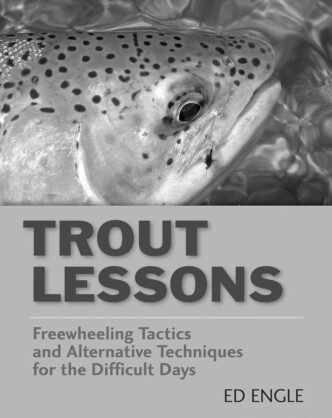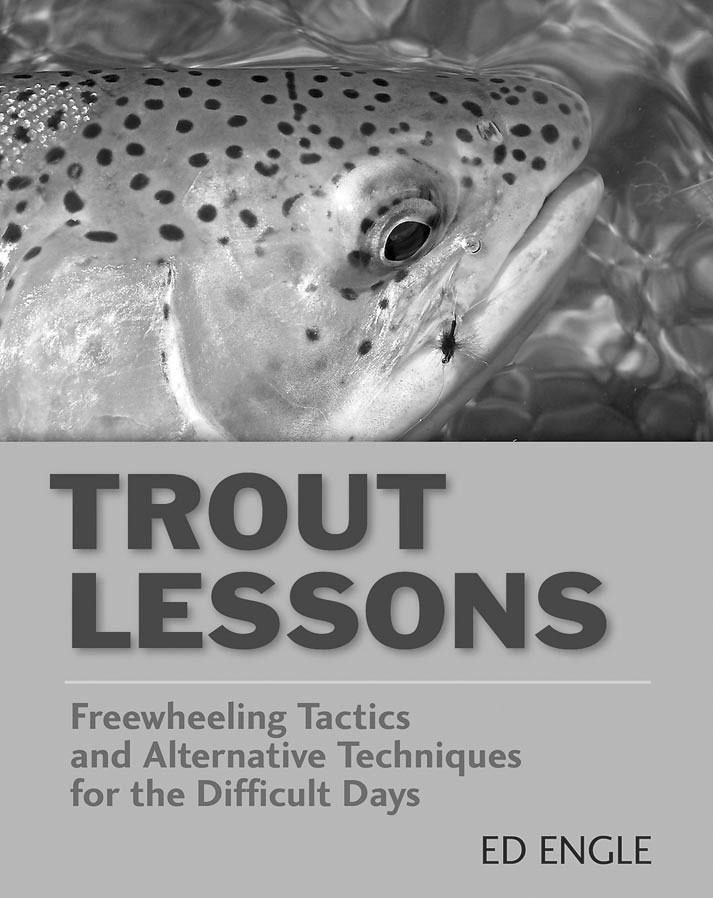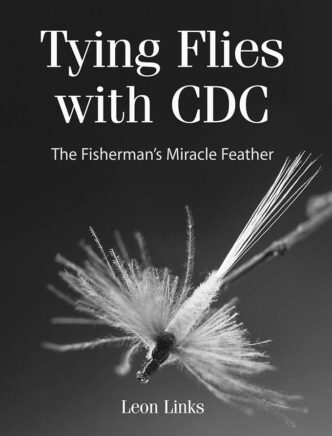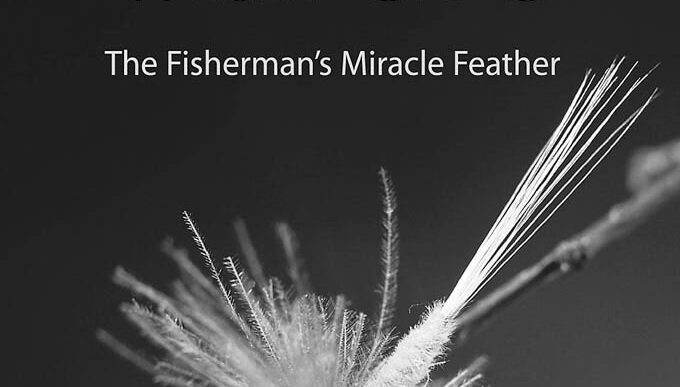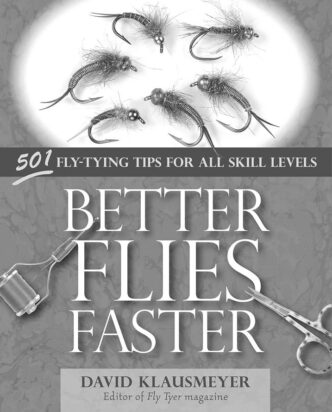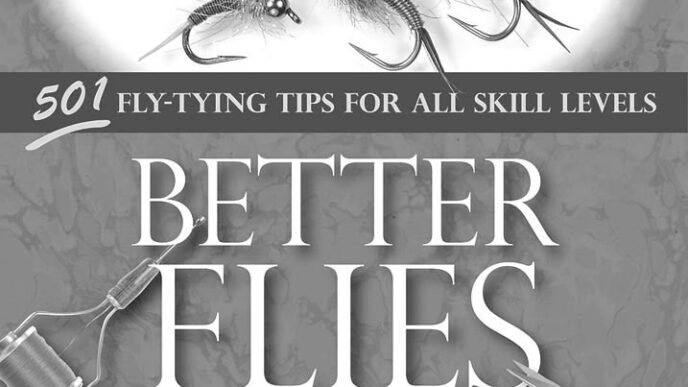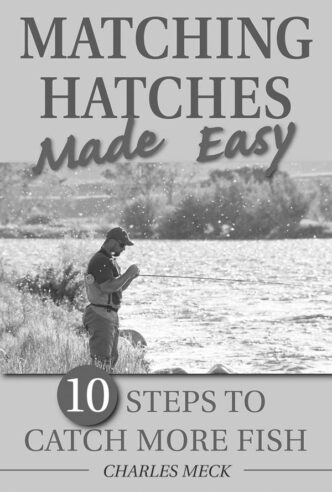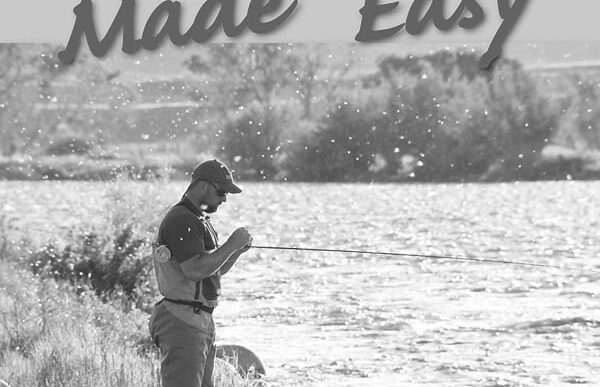Trout Lessons: Freewheeling Tactics and Alternative Techniques for the Difficult Days
By Ed Engle. Published by Stackpole Books, 2010; $29.95 hardbound.
One of my gripes about fly-fishing books that deal with angling tactics is that most just repeat the fundamentals: drag-free drifts, mending, casts around the clock face from upstream to downstream, matching the hatch — all the basics. Almost all contemporary fly-fishing books do this, in one way or another, since even fly-pattern books tend to have “how-to-fish-it” sections. Repeating the basics is helpful for beginners, of course, but if you’ve fished for much time at all or have read a few of these books, you probably are familiar with all these tactics, try hard to employ them when you fish, and actually succeed in doing so at least some of the time. They are what’s considered normal practices in modern fly fishing. They’re the way we all usually fish.
These practices don’t always work, do they? It’s possible not only to try to do everything right, but actually to fish in precisely the way it’s said one must fish in order to succeed, and still get skunked — sometimes while fish rise around you.
Ed Engle’s Trout Lessons is not like all those other books. He begins it thus: “My intentions when I started writing Trout Lessons were pretty straightforward. The plan was to give fly fishers some ideas for those days on the river when the usual stuff didn’t work.” But fairly quickly, as he thought about how he actually fishes, he realized that for him, there is no such thing as “the usual stuff.” He’s a very successful angler, after all, the storied companion of John Gierach and A. K. Best and a guide who gets clients into fish in the highly technical angling of the Colorado tailwater fisheries. Writing the book made him confront the fact that, as he puts it, “I wasn’t always the hard-core, match-the-hatch, drag-free-drift fly fisherman I thought I was.” Trout Lessons doesn’t just supplement “the usual stuff,” it broadens the definition of “the usual.” Engle believes that fly fishing isn’t a set of prescribed “normal” practices. It’s whatever fly fishers do that works. The match-the-hatch, drag-free drift approach works, of course, but so do a lot of angling tactics at odds with the prevailing conventional wisdom. As a guide, Engle appreciates the utility of indicator nymphing — it gets even rank beginners into fish — but as an angler, he thinks that it’s more important to fish nymphs without an indicator in order to develop a sense of when a fish takes a subsurface fly, because “more than anything, it’s a way to adjust your thinking to where you’re more open to the most subtle clues on the river.” That kind of open-mindedness is the underlying approach advocated here.
The folk-Zen, posthippie-wisdom aspects of that mind-set, which sometimes emerge in Gierach’s work, are most evident in the chapter on fishing small, clear mountain streams of the sort that Peter Pumphrey writes about in this magazine. Stealth is important when approaching spooky trout in these streams, as is reading the water where fish lack the obvious lies that characterize bigger water, but Engle argues that these are just a few elements of “a kind of all-around awareness or presence” that fishing such waters helps an angler to develop. That includes not fishing as a way of catching the biggest trout in small streams: “I decided that a careful, stealth approach wasn’t going to be enough” to avoid spooking these fish. “The only solution was to not move at all for a while, especially when I came to water that I thought might hold a larger fish” — waiting “fifteen to thirty minutes” or “as long as you can stand it” before making a cast. The text, which is illustrated throughout by photos of Engle, Best, and Gierach in various settings, at this point has a lovely photograph of John Gierach, sitting by a small pool on a mountain stream, very intently doing nothing.
Mostly, however, Trout Lessons advocates doing things that you usually might not do, or at least might not do deliberately, because willingness to do so is the sort of mental orientation that leads to success on the stream. As he writes in the chapter on attractor flies, “it’s all about definitions, but in fishing, a definition is nothing but a mind-set.” Consequently, “if we broaden our definitions of attractor pattern fishing, we’ll find that we can actually fish match-the-hatch imitations like we would a traditional attractor fly when there isn’t a hatch, or fish smaller versions of traditional attractor patterns in match-thehatch situations.” One result, in the case of fishing flies as attractors, is a series of tactics such as Splash and Crash, Plop and Drop, Slap and Dap, Drag and Nag (Engle likes two-term names), and the use of the Sudden Inch pioneered by Leonard Wright.
Chapter by chapter, Trout Lessons thus broadens the definition of “the usual” approaches. In “Tight-Line Tactics,” Engle notes that the traditional approach to fishing wet flies was well established by the 1970s with the addition of the Liesenring Lift and Pete Hidy’s method of swinging subsurface flies. Engle instead emphasizes tight-lining dry flies — dapping, high-sticking, and waking. And in the chapter on fishing meadow streams, he discusses going beyond fishing terrestrial patterns such as grasshopper imitations and fishing streamers close to the bank.
The chapter on fishing high water and run-off-swelled streams really opens up the conventional approach. In such situations, the conventional definition of how to fish is simple: don’t. Go tie flies, take up golf, run for political office — just don’t even think about fishing, because the fish are hiding and the water is opaque with silt. Engle has not only thought about fishing high water, he’s developed ways to do so effectively. In this year of high and belated run-offs and wet weather in California and through-out the West, this chapter, in particular, is worth the price of the book for frustrated fly rodders.
The open-minded approach also obviously pays dividends in the chapter “Catching Difficult Trout,” which of course are not necessarily the largest trout, just the most challenging, an approach that Engle redefines, following E. R. Hewitt, as “catching a trout the way you want to catch it.” And open-mindedness defines the subject matter of the chapter called “Oddities,” a compendium of things that just plain work, whether we know why or not, including fishing sunken dry flies, fishing Catskill “spiders” (flies consisting only of long, stiff hackles tied on short, light-wire hooks and danced across the surface), and adding blue accents and flash to flies, even if no such color appears on any natural being imitated.
Although the techniques that Engle discusses would work anywhere, there’s an added, if unintended bonus for California fly fishers. All the photos that accompany the text apparently were shot in Colorado, but they very well could have been shot in California, instead, because the waters depicted there are dead ringers for similar water types in the Golden State, from the Sacramento, to the Truckee and Little Truckee, to the lower Owens, to Hat
Creek and Hot Creek, to the small streams of the Sierra. Reading it, you know exactly where and when you’d apply its advice.
This is not a book that advocates “thinking outside the box,” to use that trite phrase. Its message is that there is no box: Go fish — and keep your eyes and your mind open.
Bud Bynack
Tying and Fishing Tailwater Flies: 500 Step-by-Step Photos of 24 Proven Patterns
By Pat Dorsey. Published by Headwater Books/Stackpole books, 2010; $39.95 hardbound.
Name a major California trout stream, and you’ve probably named a tailwater fishery. Dams and their consequences for fish, both good and bad, are a fact of life in our state, as they are throughout the West. The cold outflow below dams both makes some fisheries possible and determines the environment in which fish and their food must live. The fisheries of the lower Sacramento River, the Pit, and the Truckee and Little Truckee, just to name a few, are all influenced by dams, especially in the stretches immediately downstream of the impoundment. So around here, a book called Tying and Fishing Tailwater Flies might well be called just Tying and Fishing Flies: Proven Patterns. It’s basically a collection of flies that have worked well in the kinds of places we all fish.
Pat Dorsey is a guide and commercial fly tyer in Colorado, and Colorado tailwaters — think the South Platte River, or Cheesman Canyon — have the reputation of being small-fly fisheries. Ed Engle, for example, has written a couple of books about tying and fishing small flies, based on his experiences there. But just as with California’s tailwater fisheries, what works runs the gamut from midges to big attractors. There are a lot of recipes in Tying and Fishing Tailwater Flies that specify size 18 to 24 hooks, but there are other flies featured, as well, ranging from the classic Renegade and a Wullf-ish attractor of Dorsey’s own design to Bob Jacklin’s recent Amy’s Ant, which isn’t an ant pattern at all, but one of those big “One Fly” flies that aspires to be all things to all fish and that has more closed-cell foam than a pair of neoprene waders and more tying steps than Dancing with the Stars.
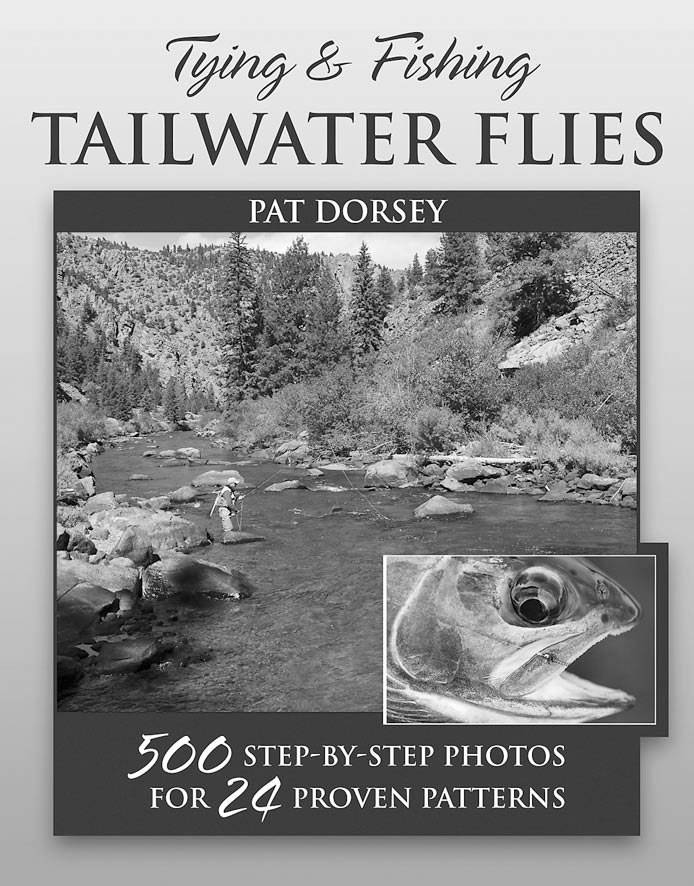
As Dorsey says, though, his patterns are for the most part simple “guide flies,” and what makes them interesting, rather than just another collection of flies that work (lots of flies work, if fished properly) is their creative use of materials. Dorsey has paid his dues at the vise — one year, he tied over 2,300 dozen flies — and has thought a lot about both what works there and what works on the stream. Many of the patterns, from midges and small mayfly nymphs to caddis pupae, bear the label “Mercury” in their names, reflecting the use of a clear, silver-lined bead that looks like a blob of mercury and that gives an extra dimension to the patterns to which it is added. Likewise, Dorsey makes use of Tyvek — the white vapor barrier that you see on houses under construction, before the siding goes on — for wing cases, colored with permanent markers, and he also as creatively employs McFlylon, chamois, and a synthetic embroidery thread called Glamour Madera that can be used for emerging wings on midges.
If you fish in California, chances are that you fish tailwaters. If such innovations interest you — or if you just want to know what Amy’s Ant, which is said to have been “inspired” by Dick Cheney, looks like — check out Tying and Fishing Tailwater Flies.
Bud Bynack
Soulfish 2: Fish Mode
DVD written, filmed, directed, and produced by Mike E. Weir. Burl Productions, $29.95; available from http://fisheyevideos.com.
“For some people, fishing is purely recreational. For others, it’s a way to make a living. For some, it is simply a way of life. . . . All fishermen have something in common, though: they have a story to tell. These are the most hard-core, dedicated anglers on the planet, and this is their story.” So begins Mike E. (Mikey) Weir’s latest video, Soulfish 2: Fish Mode.
The vast majority of fishing-destination movies are nothing but a way to get a cheap trip or to disguise an ill-disguised infomercial about gear, guides, or a lodge. Soulfish 2: Fish Mode is none of those things. It truly is a story.
The story starts with a look back at old-school fly fishing as done in the 1940s. (I get to play the old guy . . . no acting required.) Then it segues into Mikey doing his own version of old school, with bamboo and small-stream trout. Just about the time you’ve seen enough dancing with small streams, you get wrenched into a raging tug-of-war with monster Mongolian taimen on an unfished stretch of huge and distant water.
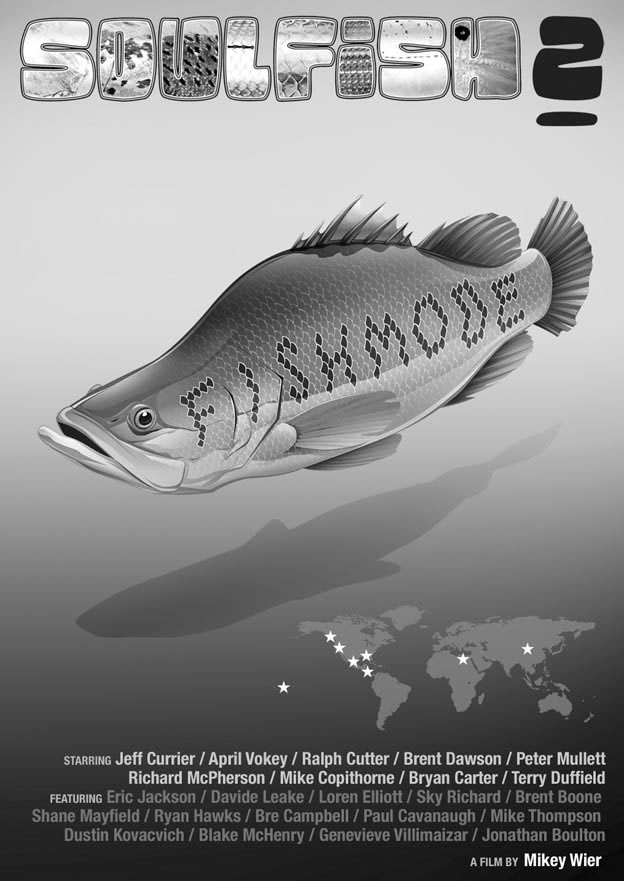
The entire video is like that. Mikey’s home waters of California bookend seven hot fishing destinations that span the globe. Just as you begin to think you’ve seen enough of something, without warning, you get whipsawed into a place and style of fishing 180 degrees opposed to the last scene. Of all the fishing-film producers out there, Mikey is the only one who has truly captured the stylistic essence of the movies shot by Warren Miller, the maker of gonzo skiing and snowboarding films.
British Columbia steelheading with April Vokey is crazy: gorgeous scenery, ridiculously long casts, big chromers, and of course, April knows how to flash a smile that can melt your remote.
Mike Copithorne neatly casts up a slam from his wheelchair in Belize, and then we’re hopscotching over scalding Egyptian sandstone following Jeff Currier and crew as they plunder Lake Nasser of its tiger fish and industrial-sized Nile perch. In between all that, we’ve been to
Louisiana, Mexico, and Hawaii. The story that unfolds in the process is better than a fairy tale, because it’s true. The final chapter brings us back home, where Mikey narrates, “When people ask me the single coolest place I’ve ever fished, I instantly say. . . [pause for effect] California.”
The filming is first rate. Mikey even uses a tripod (and a boom), which seems to be a lost art among videographers. His pans are spot-on, and sight lines are accurate, even when the going gets crazy. In trying to make this sound like a balanced review, I could end by saying the only thing wrong with the video is that there isn’t enough of it. But that wouldn’t be true. Its run time, 90 minutes, is perfect. Every part of the story is told to completion without an extra minute needed. Highly recommended.
Ralph Cutter
Conifers of California
By Ronald M. Lanner. Published by Cachuma Press, 2007; $24.95 softbound.
It’s pretty much a truism that trout are found in beautiful places, and certainly, when fishing in California, these beautiful places often involve forests. Whether hiking, camping, or merely contemplating the world, many of us enjoy spending time amid trees. As an angler, however, I derive more than aesthetic pleasure from their presence. Trees are critical for sustaining healthy fisheries: the shadows of trees cool the water and provide security for fish, their roots hold the soil in place, they serve as habitat for some of the creatures that fish feed upon, and they create habitat for fish as well when they fall across a stream or into a lake.
The commonest type of tree in trout country is the conifer, of which our state has 52 species. If you’re curious about the characteristics of these cone bearers that too often serve as unwanted homes for our wayward flies, pick up a copy of Ronald M. Lanner’s Conifers of California. The book’s color photographs are both numerous and excellent, and the paintings of cones and needles by Eugene O. Murman are pleasing to the eye and highly useful for tree identification. Maps are included that show the distribution of each species across the state.
Richard Anderson



